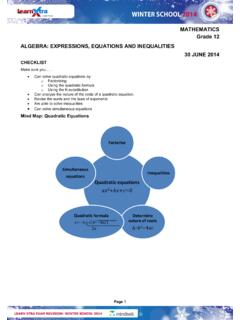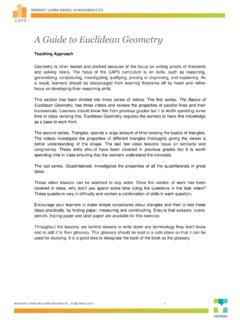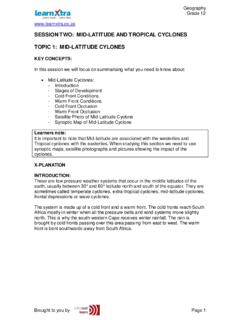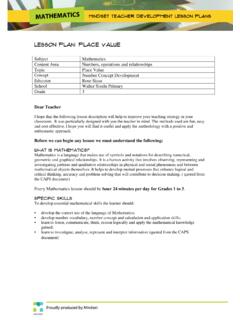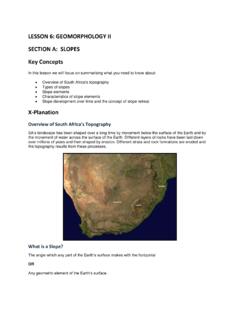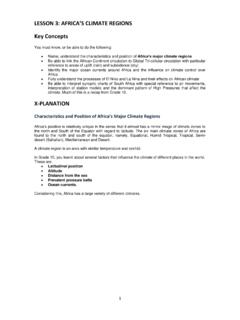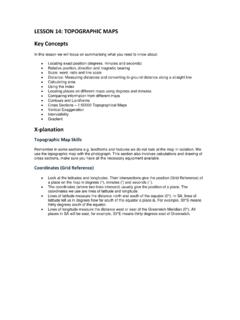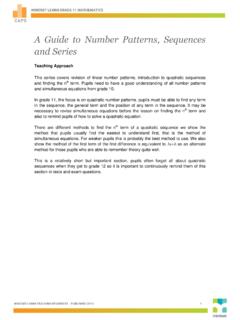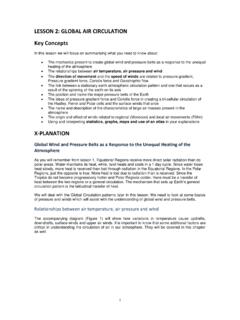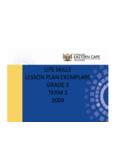Transcription of A Guide to Trigonometry for Beginners - Mindset Learn
1 A Guide to Trigonometry for Beginners Teaching Approach When teaching Trigonometry , start with a recap the theorem of Pythagoras followed by defining the trigonometric ratios in a right angles triangle. A lot of examples are recommended to ensure proper understanding in recognizing the opposite, adjacent and hypotenuse sides. Triangles with the numerical length of sides and algebraic lengths of sides are recommended. The proper use of the calculator must be stressed.
2 Learners must not be restricted to just remembering the important keys, but a proper explanation of the reasoning behind pressing the sin, cos and tan keys, compared to Shift sin, Shift cos and Shift tan. The responsibility lies with the learners to ensure that their calculator is set in degrees. Once learners are able to solve angles and sides in right angled triangles, the link to similar triangles can be bridged. The important concept of sides in the same ratio does not affect the angle.
3 This concept can be further developed by using similar triangles to determine angles and sides of triangles which otherwise would be difficult to determine. The following example will illustrate this point: We can use similar triangles to determine the height of the tree in the example The shadow that a tree casts is used in the following way: we put a pole of a certain height (example 2m) in the line of the shadow, we measure the distance from the tree to where the shadow hits the horizontal (example 20m) and measuring the distance from the pole to where the shadow hits the horizontal (8m), we can use similar triangles and trigonometric ratios in the following way to determine the height of the tree: 2: tan8.
4 Tan20220 220885In ABCxIn ADExxxm Other uses of Trigonometry and similar triangles must be highlighted to ensure learners see the relevance of trigonometric definitions. Trigonometry and Similar triangles are used in engineering, architecture, construction etc. Hints on solving Trigonometry problems: If no diagram is given, draw one yourself. Mark the right angles in the diagram. Show the sizes of the other angles and the lengths of any lines that are known Mark the angles or sides you have to calculate.
5 Consider whether you need to create right triangles by drawing extra lines. For example, divide an isosceles triangle into two congruent right triangles. Decide whether you will need Pythagoras theorem, sine, cosine or tangent. Check that your answer is reasonable. The hypotenuse is the longest side in a right triangle Video Summaries Some videos have a PAUSE moment, at which point the teacher or learner can choose to pause the video and try to answer the question posed or calculate the answer to the problem under discussion.
6 Once the video starts again, the answer to the question or the right answer to the calculation is given. Mindset suggests a number of ways to use the video lessons. These include: Watch or show a lesson as an introduction to a lesson Watch of show a lesson after a lesson, as a summary or as a way of adding in some interesting real-life applications or practical aspects Design a worksheet or set of questions about one video lesson. Then ask learners to watch a video related to the lesson and to complete the worksheet or questions, either in groups or individually Worksheets and questions based on video lessons can be used as short assessments or exercises Ask learners to watch a particular video lesson for homework (in the school library or on the website, depending on how the material is available) as preparation for the next days lesson.
7 If desired, learners can be given specific questions to answer in preparation for the next day s lesson 1. Introduction to Trigonometry This video gives brief description of how Trigonometry was first discovered and used. It also describes the practical application of Trigonometry through the theodolite, as used by land surveyors. 2. Introduction to Sin, Cos and Tan This video covers the fundamental definitions of the Trigonometry . It explains that Trigonometry is ultimately the relationship between ratios of sides of triangles with respect to an angle in that triangle.
8 3. Basic Use of Sin, Cos and Tan In this lesson we will use sin, cos and tan ratios in right angled triangles. We start by revising the definitions. 4. Using to Calculating a Side This video covers the first of the application videos in which we use the trigonometric ratios to determine the length of a side in a right angled triangle. The emphasis is on choosing the correct trigonometric ratio. 5. Using Trigonometric to Calculate an Angle This video covers the second of the application videos in which we use the trigonometric ratios to determine the size of an angle, given at least two sides in the right angled triangle.
9 6. Introducing Trigonometry on the Cartesian Plane In this lesson we look at we will be looking at the trigonometric ratios on the Cartesian Plane. 7. Application of Trigonometry on the Cartesian Plane In this video we apply what we know about trigonometric ratios on the Cartesian Plane. We determine lengths of sides by sketching a right angle triangle in the correct quadrants according the given information. 8. Introducing Cosec, Sec and Cot This lesson introduces learners to the three reciprocals of sign, cos and tan, namely cosec, sec and cot 9.
10 Introducing Special Angles In this video we introduce special angles of which the trigonometric ratios can be derived without the use of a calculator. We derive these special triangles by using the Cartesian Plan with a circle with centre at the origin and with radius 2. 10. Solving Basic Trigonometric Equations In this video we solve trigonometric equations. Learners are exposed to solving equations using a calculator and solving equations without the use of a calculator. The important calculator steps are outlined.
